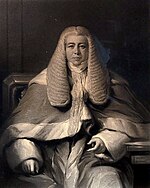Master of the Rolls (Ireland)
The Master of the Rolls in Ireland was a senior judicial office in the
History of the Office
Until the sixteenth century, the Master of the Rolls was always a
The Master might act through a Deputy if he was incapacitated or absent on official business, although no actual office of Deputy Master is known to have existed. William Sutton acted as Deputy to his uncle Robert Sutton in the 1420s and Thomas Archbold deputised for Thomas Dowdall in 1479.

In the seventeenth and eighteenth centuries, the office of Master was notoriously a sinecure for absentee politicians, some of them British. Some of the appointments have been described as "farcical". Richard Rigby is said never to have set foot in Ireland during the 30 years he held the office, and William FitzGerald, 2nd Duke of Leinster, who succeeded him, had no qualifications whatever for judicial office.
Nineteenth-century reforms
In the nineteenth century, the office became a full-time judicial position: the Master acted as Deputy to the
Supersession
The 1922 Constitution of the Irish Free State prescribed a new court system for the new State but allowed the existing system, based on the Supreme Court of Judicature Act (Ireland) 1877, to persist as a transitional measure.[1] In 1923, Charles Andrew O'Connor as Master of the Rolls participated in the Judiciary Committee established by the Free State Executive Council which planned the Courts of Justice Act 1924.[2] In this capacity he caused controversy by refusing to admit an affidavit written in Irish because he did not know the language.[2] When the 1924 Act was passed, O'Connor became a judge of the new Supreme Court.[2] The officers of the Chamber of the Master of the Rolls were transferred in 1926 to the Examiner's Office.[3]
List of Masters of the Rolls in Ireland

- 1333 Edmund de Grimsby
- 1334 William de Bardelby
- 1337 Robert de Hemmingburgh
- 1346 William de Whithurst
- 1350 Robert (or Henry) de Leycestre
- c.1370 Thomas de Cottingham
- 1372 Thomas de Thelwall, later Chancellor of the Duchy of Lancaster (England)
- 1377 Robert Sutton, later Chief Baron of the Irish Exchequer, first term
- 1386 Dean of St. Patrick's Cathedral
- 1395 Robert de Faryngton, or de Farrington, later Lord High Treasurer of Ireland
- 1395 Robert Sutton, second term
- 1395 John de Kirkby
- 1404 Robert Sutton, third term
- 1427 Richard Ashwell
- 1430 William Sutton
- 1436 Robert Dyke, later Lord High Treasurer of Ireland
- 1450 John Chevir, later Lord Chief Justice of Ireland
- 1461 Patrick Cogley (exchanged the position for Clerk of the Crown and Hanaper)
- 1461 Peter Trevers
- 1471 Thomas Dowdall
- 1492 Thomas Butler
- 1496 John Payne, Bishop of Meath
- 1513 Dean of St. Patrick's Cathedral
- 1521 Walter Wellesley, Bishop of Kildare
- 1522 Dean of St. Patrick's Cathedral, first term
- 1523 Dean of St. Patrick's Cathedral
- 1528 Thomas Darcy, second term
- 1530 Anthony Skeffington
- 1533 John Alan, later Lord Chancellor of Ireland
- 1539 Robert Cowley
- 1542 Thomas Cusack, later Lord Chancellor of Ireland
- 1543 Nicholas Wycombe
- 1550 Patrick Barnewall
- 1552 John Parker
- 1566 Henry Draycott
- 1572 Nicholas White, first term
- 1578 Edward Fitz-Symon
- 1578 Nicholas White, second term
- 1593 Anthony St Leger
- 1609 Francis Aungier, 1st Baron Aungier of Longford
- 1633 Christopher Wandesford
- 1641 Sir John Temple
- 1677 Sir William Temple, 1st Baronet, first term
- 1689 Sir William Talbot, 3rd Baronet
- 1690 Sir William Temple, second term
- 1696 William Berkeley, 4th Baron Berkeley of Stratton
- 1731 Thomas Carter
- 1754 Henry Singleton
- 1759 Richard Rigby
- 1788 William Robert Fitzgerald, 2nd Duke of Leinster
- 1789 John Crosbie, 2nd Earl of Glandore
and John Proby, 1st Earl of Carysfort
(jointly) - 1801 Sir Michael Smith, 1st Baronet
- 1806 John Philpot Curran
- 1814 Sir William MacMahon, 1st Baronet
- 1837 Sir Michael O'Loghlen, 1st Baronet
- 1842 Francis Blackburne
- 1846 Thomas Berry Cusack Smith
- 1866 John Edward Walsh
- 1870 Sir Edward Sullivan, 1st Baronet
- 1883 Sir Andrew Porter, 1st Baronet
- 1906 Richard Edmund Meredith
- 1912 Charles Andrew O'Connor(last holder)
The office was abolished in 1924.
See also
References
- ^ "Constitution of the Irish Free State". Irish Statute Book. 1922. Articles 64–72, 75–76. Archived from the original on 4 March 2016. Retrieved 21 September 2016.
- ^ a b c Dougherty, James I. (22 April 2009). From the Ashes Arose Justice: The Creation of an Irish Judiciary, 1922–1924 (PDF) (Thesis). Carnegie Mellon University: Dietrich College of Humanities and Social Sciences. Archived from the original on 23 September 2016. Retrieved 21 September 2016.
- ^ "Court Officers Act, 1926 section 13". Irish Statute Book. Archived from the original on 23 September 2016. Retrieved 21 September 2016.
Sources
- The Oxford Companion to Law, ed David M Walker, 1980
- The Judges in Ireland 1221–1921, F. Elrington Ball, 1926
- Chronicle of the Law Officers of Ireland Constantine Joseph Smyth 1839
